Atmospheric Deposition around the Industrial Areas of Milazzo and Priolo Gargallo (Sicily–Italy)—Part A: Major Ions
Abstract
1. Introduction
2. Study Area and Climatic Setting
3. Materials and Methods
3.1. Analysis of Chemical Data
4. Results and Discussion
4.1. Chemical Composition
4.2. Sources and Processes
4.3. Atmospheric Deposition Fluxes for Major Ions
5. Conclusions
Author Contributions
Funding
Institutional Review Board Statement
Informed Consent Statement
Data Availability Statement
Acknowledgments
Conflicts of Interest
References
- D’Alessandro, W.; Katsanou, K.; Lambrakis, N.; Bellomo, S.; Brusca, L.; Liotta, M. Chemical and isotopic characterisation of bulk deposition in the Louros basin (Epirus, Greece). Atmos. Res. 2013, 132–133, 399–410. [Google Scholar] [CrossRef]
- Galy-Lacaux, C.; Laouali, D.; Descroix, L.; Gobron, N.; Liousse, C. Long term precipitation chemistry and wet deposition in a remote dry savanna site in Africa (Niger). Atmos. Chem. Phys. 2009, 9, 1579–1595. [Google Scholar] [CrossRef]
- Amodio, M.; Catino, S.; Dambruoso, P.R.; De Gennaro, G.; Di Gilio, A.; Giungato, P.; Laiola, E.; Marzocca, A.; Mazzone, A.; Sardaro, A.; et al. Atmospheric deposition: Sampling procedures, analytical methods, and main recent findings from the scientific literature. Adv. Meteorol. 2014, 2014, 161730. [Google Scholar] [CrossRef]
- Schlesinger, W.H. Biogeochemistry: An Analysis of Global Change; Academic Press: New York, NY, USA, 1997. [Google Scholar]
- Tang, A.; Zhuang, G.; Wang, Y.; Yuan, H.; Sun, Y. The chemistry of precipitation and its relation to aerosol in Beijing. Atmos. Environ. 2005, 39, 3397–3406. [Google Scholar] [CrossRef]
- Arsene, C.; Olariu, R.I.; Mihalopoulos, N. Chemical composition of rainwater in the northeastern Romania, Iasi region (2003–2006). Atmos. Environ. 2007, 41, 9452–9467. [Google Scholar] [CrossRef]
- Sickles, J.E.; Grimm, J.W. Wet deposition from clouds and precipitation in three high elevation regions of the Eastern United States. Atmos. Environ. 2003, 37, 277–288. [Google Scholar] [CrossRef]
- Ye, L.; Huang, M.; Zhong, B.; Wang, X.; Tu, Q.; Sun, H.; Wang, C.; Wu, L.; Chang, M. Wet and dry deposition fluxes of trace elements in Pearl River Delta Region (China): Characteristics, ecological risk assessment, and source apportionment. J. Environ. Sci. 2018, 70, 106–123. [Google Scholar] [CrossRef]
- Keene, W.C.; Pszenny, A.P.; Galloway, J.N.; Hawley, M.E. Sea-salt corrections and interpretation of constituent ratios in marine precipitation. J. Geophys. Res. Atmos. 1986, 91, 6647–6658. [Google Scholar] [CrossRef]
- Moreda-Piñeiro, J.; Alonso-Rodríguez, E.; Turnes-Carou, I.; Moscoso-Pérez, C.; Blanco-Heras, G.; Tellado, L.G.; López-Mahía, P.; Muniategui-Lorenzo, S.; Prada-Rodríguez, D. Inorganic ions and trace metals bulk deposition at an Atlantic Coastal European region. J. Atmos. Chem. 2017, 74, 1–21. [Google Scholar] [CrossRef]
- Arimoto, R.; Duce, R.A.; Ray, B.J.; Hewitt, A.D.; Williams, J. Trace elements in the atmosphere of American Samoa: Concentrations and deposition to the tropical South Pacific. J. Geophys. Res. 1987, 92, 8465. [Google Scholar] [CrossRef]
- Berner, E.K.; Berner, R.A. Global Water Cycle: Chemical Composition and Environment; Prentice-Hall Inc.: Englewood Cliffs, NJ, USA, 1987; p. 397. [Google Scholar]
- Halstead, M.J.R.; Cunninghame, R.G.; Hunter, K.A. Wet deposition of trace metals to a remote site in Fiordland, New Zealand. Atmos. Environ. 2000, 34, 665–676. [Google Scholar] [CrossRef]
- Wang, Y.; Wai, K.M.; Gao, J.; Liu, X.; Wang, T.; Wang, W. The impacts of anthropogenic emissions on the precipitation chemistry at an elevated site in North-eastern China. Atmos. Environ. 2008, 42, 2959–2970. [Google Scholar] [CrossRef]
- Prasad Shukla, S.; Mukesh, S. Neutralization of rainwater acidity at Kanpur, India. Tellus B Chem. Phys. Meteorol. 2010, 62, 172–180. [Google Scholar] [CrossRef]
- Seinfeld, J.H.; Pandis, S.N. Atmospheric Chemical Composition and Physics from Air Pollution to Climate Change; John Wiley and Sons, Incorporated: New York, NY, USA, 1998. [Google Scholar]
- Zufall, M.J.; Davidson, C.I. Dry deposition of particles. In Atmospheric Particles; Harrison, R.M., van Grieken, R., Eds.; John Wiley Sons: Chichester, UK, 1998; Volume 5, pp. 425–473. [Google Scholar]
- Huang, J.; Duan, Y.H.; Xu, M.G.; Zhai, L.M.; Zhang, X.B.; Wang, B.R.; Zhang, Y.Z.; Gao, S.D.; Sun, N. Nitrogen mobility, ammonia volatilization, and estimated leaching loss from long-term manure incorporation in red soil. J. Integr. Agric. 2017, 16, 2082–2092. [Google Scholar] [CrossRef]
- Wu, Q.; Han, G.; Tao, F.; Tang, Y. Chemical composition of rainwater in a karstic agricultural area, Southwest China: The impact of urbanization. Atmos. Res. 2012, 111, 71–78. [Google Scholar] [CrossRef]
- Bellomo, S.; Aiuppa, A.; D’Alessandro, W.; Parello, F. Environmental impact of magmatic fluoride emission in the Mt. Etna area. J. Volcanol. Geotherm. Res. 2007, 165, 87–101. [Google Scholar] [CrossRef]
- Brugnone, F.; D’Alessandro, W.; Calabrese, S.; Li Vigni, L.; Bellomo, S.; Brusca, L.; Prano, V.; Saiano, F.; Parello, F. A Christmas gift: Signature of the 24th December 2018 eruption of Mt. Etna on the chemical composition of bulk deposition in eastern Sicily. Ital. J. Geosci. 2020, 139, 341–358. [Google Scholar] [CrossRef]
- Ge, B.; Wang, Z.; Gbaguidi, A.E.; Zhang, Q. Source Identification of Acid Rain Arising over Northeast China: Observed Evidence and Model Simulation. Aerosol Air Qual. Res. 2016, 16, 1366–1377. [Google Scholar] [CrossRef]
- Chandra Mouli, P.; Venkata Mohan, S.; Reddy, S.J. Rainwater chemistry at a regional representative urban site: Influence of terrestrial sources on ionic composition. Atmos. Environ. 2005, 39, 999–1008. [Google Scholar] [CrossRef]
- Viana, M.; López, J.M.; Querol, X.; Alastuey, A.; García-Gacio, D.; Blanco-Heras, G.; López-Mahía, P.; Piñeiro-Iglesias, M.; Sanz, M.J.; Sanz, F.; et al. Tracers and impact of open burning of rice straw residues on PM in Eastern Spain. Atmos. Environ. 2008, 42, 1941–1957. [Google Scholar] [CrossRef]
- Guerzoni, S.; Molinaroli, E.; Rossini, P.; Rampazzo, G.; Quarantotto, G.; De Falco, G.; Cristini, S. Role of desert aerosol in metal fluxes in the Mediterranean area. Chemosphere 1999, 39, 229–246. [Google Scholar] [CrossRef]
- Loya-González, D.; López-Serna, D.; Alfaro-Barbosa, J.M.; López-Reyes, A.; González-Rodríguez, H.; Cantú-Silva, I. Chemical composition of bulk precipitation and its toxicity potential index in the metropolitan area of Monterrey, Northeastern Mexico. Environments 2020, 7, 106. [Google Scholar] [CrossRef]
- Calabrese, S.; Randazzo, L.; Daskalopoulou, K.; Milazzo, S.; Scaglione, S.; Vizzini, S.; Tramati, C.D.; D’Alessandro, W.; Brusca, L.; Bellomo, S.; et al. Mount Etna volcano (Italy) as a major “dust” point source in the Mediterranean area. Arab. J. Geosci. 2016, 9, 219. [Google Scholar] [CrossRef]
- Vet, R.; Artz, R.S.; Carou, S.; Shaw, M.; Ro, C.U.; Aas, W.; Baker, A.; Bowersox, V.C.; Dentener, F.; Galy-Lacaux, C.; et al. A global assessment of precipitation chemistry and deposition of sulfur, nitrogen, sea salt, base cations, organic acids, acidity and pH, and phosphorus. Atmos. Environ. 2014, 93, 3–100. [Google Scholar] [CrossRef]
- Ahmed, A.F.M.; Singh, R.P.V.; Elmubarak, A.H. Chemistry of atmospheric precipitation at the Western Arabian Gulf Coast. Atmos. Environ. Part A Gen. Top. 1990, 24, 2927–2934. [Google Scholar] [CrossRef]
- Edmunds, W.M. Conceptual models for recharge sequences in arid and semi-arid regions using isotopic and geochemical methods. In Groundwater Modelling in Arid and Semi-Arid Areas; Wheater, H.S., Mathias, S.A., Li, X., Eds.; Cambridge University Press: Cambridge, UK, 2010; pp. 21–37. [Google Scholar]
- Michelsen, N.; Reshid, M.; Siebert, C.; Schulz, S.; Knöller, K.; Weise, S.M.; Rausch, R.; Al-Saud, M.; Schüth, C. Isotopic and chemical composition of precipitation in Riyadh, Saudi Arabia. Chem. Geol. 2015, 413, 51–62. [Google Scholar] [CrossRef]
- Martuzzi, M.; Pasetto, R.; Martin-Olmedo, P. Industrially Contaminated Sites and Health. J. Environ. Public Health 2014, 2014, 198574. [Google Scholar] [CrossRef]
- European Environment Agency. Progress in Management of Contaminated Sites 2007. Available online: https://www.eea.europa.eu/data-and-maps/indicators/progress-in-management-of-contaminated-sites-3/assessment (accessed on 18 May 2021).
- Duplay, J.; Semhi, K.; Mey, M.; Messina, A.; Quaranta, G.; Huber, F.; Aubert, A. Geogenic versus anthropogenic geochemical influence on trace elements contents in soils from the Milazzo Peninsula. Geochemistry 2008, 74, 691–704. [Google Scholar] [CrossRef]
- Fazzo, L.; Carere, M.; Tisano, F.; Bruno, C.; Cernigliaro, A.; Cicero, M.R.; Comba, P.; Contrino, M.L.; de Santis, M.; Falleni, F.; et al. Cancer incidence in Priolo, Sicily: A spatial approach for estimation of industrial air pollution impact. Geospat. Health 2003, 11, 43–55. [Google Scholar] [CrossRef]
- ISPRA 2002. Available online: https://www.isprambiente.gov.it/it/attivita/suolo-e-territorio/siti-contaminati/siti-di-interesse-nazionale-sin (accessed on 12 December 2022).
- Bevilacqua, M.; Braglia, M. Environmental efficiency analysis for ENI oil refineries. J. Clean. Prod. 2014, 10, 85–92. [Google Scholar] [CrossRef]
- Fano, V.; Cernigliaro, A.; Scondotto, S.; Pollina Addario, S.; Caruso, S.; Mira, A.; Forastiere, F.; Perucci, C.A. Stato di Salute Della Popolazione Residente Nelle Aree ad Elevato Rischio Ambientale e nei siti di Interesse Nazionale Della Sicilia: Analisi Della Mortalità (aa 1995–2000) e dei Ricoveri Ospedalieri (aa 2001–2003); Report: Epidemiologia Sviluppo Ambientale 2019; Assessorato Sanità Dipartimento Osservatorio Epidemiologico (Regione Siciliana); Dipartimento di Epidemiologia ASL RME. Available online: https://www.epicentro.iss.it/ambiente/sicilia_sintesi (accessed on 1 November 2022).
- Zona, A.; Iavarone, I.; Buzzoni, C.; Conti, S.; Santoro, M.; Fazzo, L.; Pasetto, R.; Pirastu, R.; Bruno, C.; Ancona, C.; et al. SENTIERI: Epidemiological Study of Residents in National Priority Contaminated Sites. Fifth Report. Epidemiol. E Prev. 2016, 43 (Suppl. S1), 1–208. [Google Scholar] [CrossRef]
- Bolle, H.J. Climate, Climate Variability, and Impacts in the Mediterranean Area: An Overview. In Mediterranean Climate. Regional Climate Studies; Springer: Berlin/Heidelberg, Germany, 2008. [Google Scholar] [CrossRef]
- Liotta, M.; Bellissimo, S.; Favara, R.; Valenza, M. Isotopic composition of single rain events in the central Mediterranean. J. Geophys. Res. 2008, 113, D16304. [Google Scholar] [CrossRef]
- Calabrese, S.; Aiuppa, A.; Allard, P.; Bagnato, E.; Bellomo, S.; Brusca, L.; Parello, F. Atmospheric sources and sinks of volcanogenic elements in a basaltic volcano (Etna, Italy). Geochim. Cosmochim. Acta 2011, 75, 7401–7425. [Google Scholar] [CrossRef]
- WMO. Guide to Meteorological Instrument and Observing Practice; WMO No. 8 2018; WMO: Geneva, Switzerland, 2018. [Google Scholar]
- EMEP/CCC. Manual for Sampling and Chemical Analysis. EMEP Cooperative Program for Monitoring and Heavy Metals and POP Measurements 2009; EMEP/CCC: 2009; NILU: Oslo, Norway, 2009. [Google Scholar]
- Harmens, H.; Mills, G.; Hayes, F.; Williams, P. ICP Vegetation Annual Report–2003/2004. ICP Vegetation 2004. Available online: https://icpvegetation.ceh.ac.uk/icp-vegetation-annual-report-20032004 (accessed on 13 December 2022).
- Brugnone, F.; Calabrese, S.; D’Alessandro, W.; Parello, F.; Li Vigni, L.; Saiano, F.; Liotta, M.; Bellomo, S.; Brusca, L.; Sprovieri, M.; et al. Major ions and trace elements composition of rainwater around the two industrial areas of Milazzo and Priolo Gargallo (Sicily—Italy), Version 1.0. Interdisciplinary Earth Data Alliance (IEDA). Int. J. Environ. Res. Public Health, 2023; in print. [Google Scholar] [CrossRef]
- Wang, L.; Shen, Z.; Lu, D.; Zhang, Q.; Zhang, T.; Lei, Y.; Xu, H. Water-soluble components in rainwater over Xi’an in northwest China: Source apportionment and pollution controls effectiveness evaluation. Atmos. Pollut. Res. 2019, 10, 395–403. [Google Scholar] [CrossRef]
- Loye-Pilot, M.D.; Martin, J.M. The Impact of Desert Dust Across the Mediterranean; Guerzoni, S., Chester, S., Eds.; Kluwer Academic Publishers: Dordrecht, The Netherlands, 1996. [Google Scholar]
- Conradie, E.H.; Van Zyl, P.G.; Pienaar, J.J.; Beukes, J.P.; Galy-Lacaux, C.; Venter, A.D.; Mkhatshwa, G.V. The chemical composition and fluxes of atmospheric wet deposition at four sites in South Africa. Atmos. Environ. 2016, 146, 113–131. [Google Scholar] [CrossRef]
- Possanzini, M.; Buttini, P.; Di Palo, V. Characterization of a rural area in terms of dry and wet deposition. Sci. Total Environ. 1988, 74, 111–120. [Google Scholar] [CrossRef]
- APHA; AWWA; WEF. Standard Methods for the Examination of Water and Wastewater, 21st ed.; American Public Health Association: Washington, DC, USA, 2005. [Google Scholar]
- Laouali, D.; Galy-Lacaux, C.; Diop, B.; Delon, C.; Orange, D.; Lacaux, J.P.; Akpo, A.; Lavenu, F.; Gardrat, E.; Castera, P. Long term monitoring of the chemical composition of precipitation and wet deposition fluxes over three Sahelian savannas. Atmos. Environ. 2012, 50, 314–327. [Google Scholar] [CrossRef]
- Al-Momani, I.F.; Ataman, O.Y.; Anwari, A.M.; Tuncel, S.; Köse, C.; Tuncel, G. Chemical composition of precipitation near an industrial area at Izmir, Turkey. Atmos. Environ. 1995, 29, 1131–1143. [Google Scholar] [CrossRef]
- Al-Momani, I.F.; Momani, K.A.; Jaradat, Q.M.; Massadeh, A.M.; Yousef, Y.A.; Alomary, A.A. Atmospheric deposition of major and trace elements in Amman, Jordan. Environ. Monit. Assess. 2008, 136, 209–218. [Google Scholar] [CrossRef]
- Xing, J.; Song, J.; Yuan, H.; Li, X.; Li, N.; Duan, L.; Qu, B.; Wang, Q.; Kang, X. Chemical characteristics, deposition fluxes and source apportionment of precipitation components in the Jiaozhou Bay, North China. Atmos. Res. 2017, 190, 10–20. [Google Scholar] [CrossRef]
- Kita, I.; Sato, T.; Kase, Y.; Mitropoulos, P. Neutral rains at Athens, Greece: A natural safeguard against acidification of rains. Sci. Total Environ. 2004, 327, 285–294. [Google Scholar] [CrossRef] [PubMed]
- Tan, J.H.; Duan, J.C.; Ma, Y.L.; Yang, F.M.; Cheng, Y.; He, K.B.; Yu, Y.C.; Wang, J.W. Source of atmospheric trace elements in winter in Foshan, China. Sci. Total Environ. 2014, 493, 262–270. [Google Scholar] [CrossRef] [PubMed]
- Mphepya, J.N.; Pienaar, J.; Galy-Lacaux, C.; Held, G.; Turner, C.-R.; Mphepya, J.N.; Pienaar, J.J.; Galy-Lacaux, C.; Turner, C.R. Precipitation chemistry in semi-arid areas of Southern Africa: A case study of a rural and an industrial site. J. Atmos. Chem. 2004, 47, 1–24. [Google Scholar] [CrossRef]
- Nirel, R.; Dayan, U. On the Ratio of Sulfur Dioxide to Nitrogen Oxides as an Indicator of Air Pollution Sources. J. Appl. Meteorol. Climatol. 2001, 40, 1209–1222. [Google Scholar] [CrossRef]
- Bellomo, S.; D’Alessandro, W.; Longo, M. Volcanogenic fluoride in rainwater around active degassing volcanoes: Mt. Etna and Stromboli Island, Italy. Sci. Total Environ. 2003, 30, 175–185. [Google Scholar] [CrossRef] [PubMed]
- Pennisi, M.; le Cloarec, M.F. Variations of Cl, F, and S in Mount Etna’s plume, Italy, between 1992 and 1995. J. Geophys. Res. Solid Earth 1998, 103, 5061–5066. [Google Scholar] [CrossRef]
- Abita, A.M.; Basiricò, L.; Pampalone, V. L’inventario Delle Emissioni in Atmosfera Della Regione Siciliana. Revisione Dell’aggiornamento All’anno 2015; U.O.C. Qualità dell’aria. ARPA SICILIA: Palermo, Italy, 2022. [Google Scholar]
- Andres, R.J.; Kyle, P.R.; Chuan, R.L. Sulphur dioxide, particle and elemental emissions from Mt. Etna, Italy during July 1987. Geol. Rundsch. 1993, 82, 687–695. [Google Scholar] [CrossRef]
- Pieri, L.; Matzneller, P.; Gaspari, N.; Marotti, I.; Dinelli, G.; Rossi, P. Bulk atmospheric deposition in the southern Po Valley (Northern Italy). Water Air Soil Pollut. 2010, 210, 155–169. [Google Scholar] [CrossRef]
- Morales-Baquero, R.; Pulido-Villena, E.; Reche, I. Chemical signature of Saharan dust on dry and wet atmospheric deposition in the south-western Mediterranean region. Tellus B Chem. Phys. Meteorol. 2013, 65, 18720. [Google Scholar] [CrossRef]
- Castillo, S.; Alastuey, A.; Cuevas, E.; Querol, X.; Avila, A. Quantifying Dry and Wet Deposition Fluxes in Two Regions of Contrasting African Influence: The NE Iberian Peninsula and the Canary Islands. Atmosphere 2017, 8, 86. [Google Scholar] [CrossRef]
- Cerro, J.C.; Cerdà, V.; Caballero, S.; Bujosa, C.; Alastuey, A.; Querol, X.; Pey, J. Chemistry of dry and wet atmospheric deposition over the Balearic Islands, NW Mediterranean: Source apportionment and African dust areas. Sci. Total Environ. 2020, 747, 141187. [Google Scholar] [CrossRef] [PubMed]
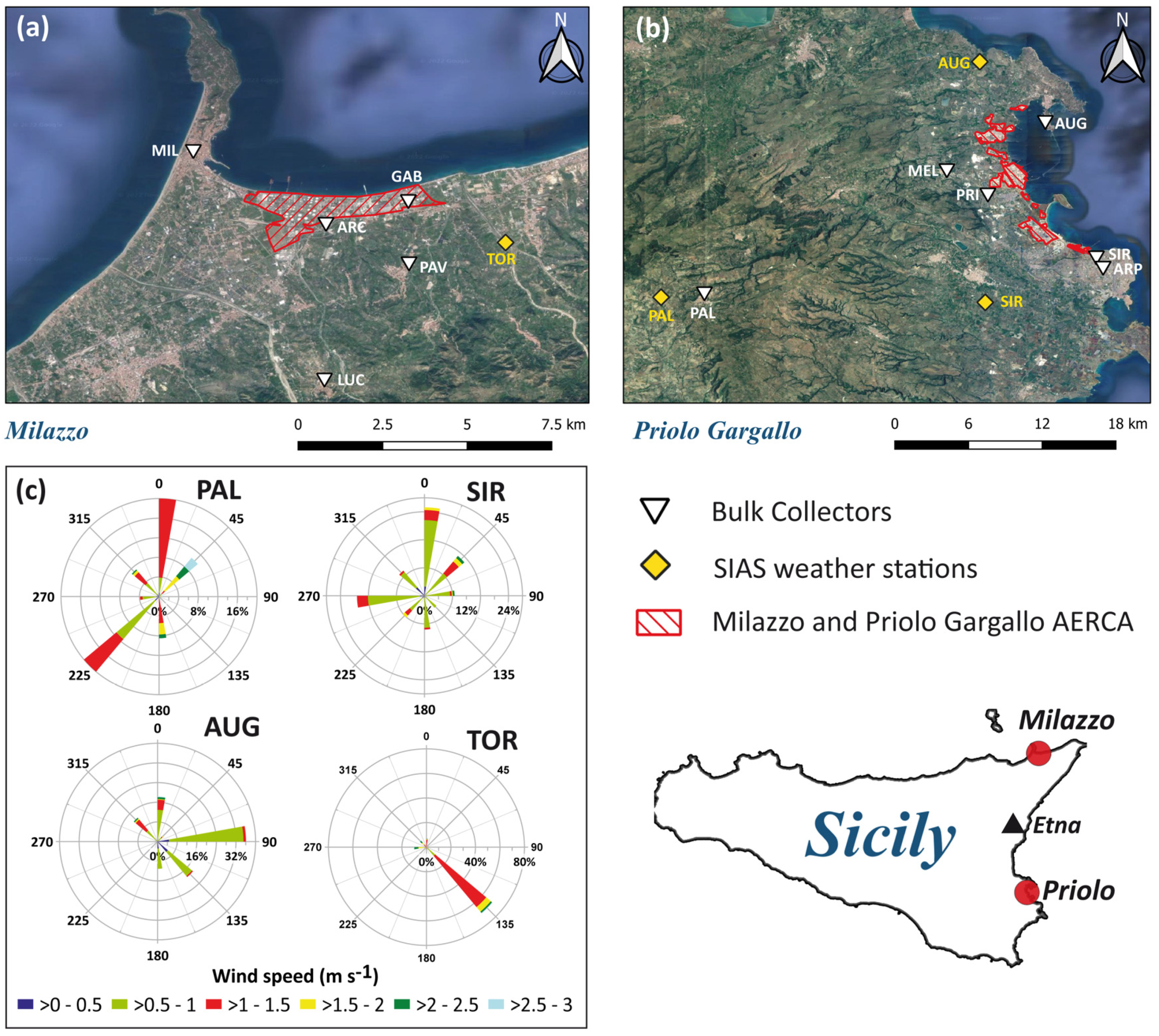
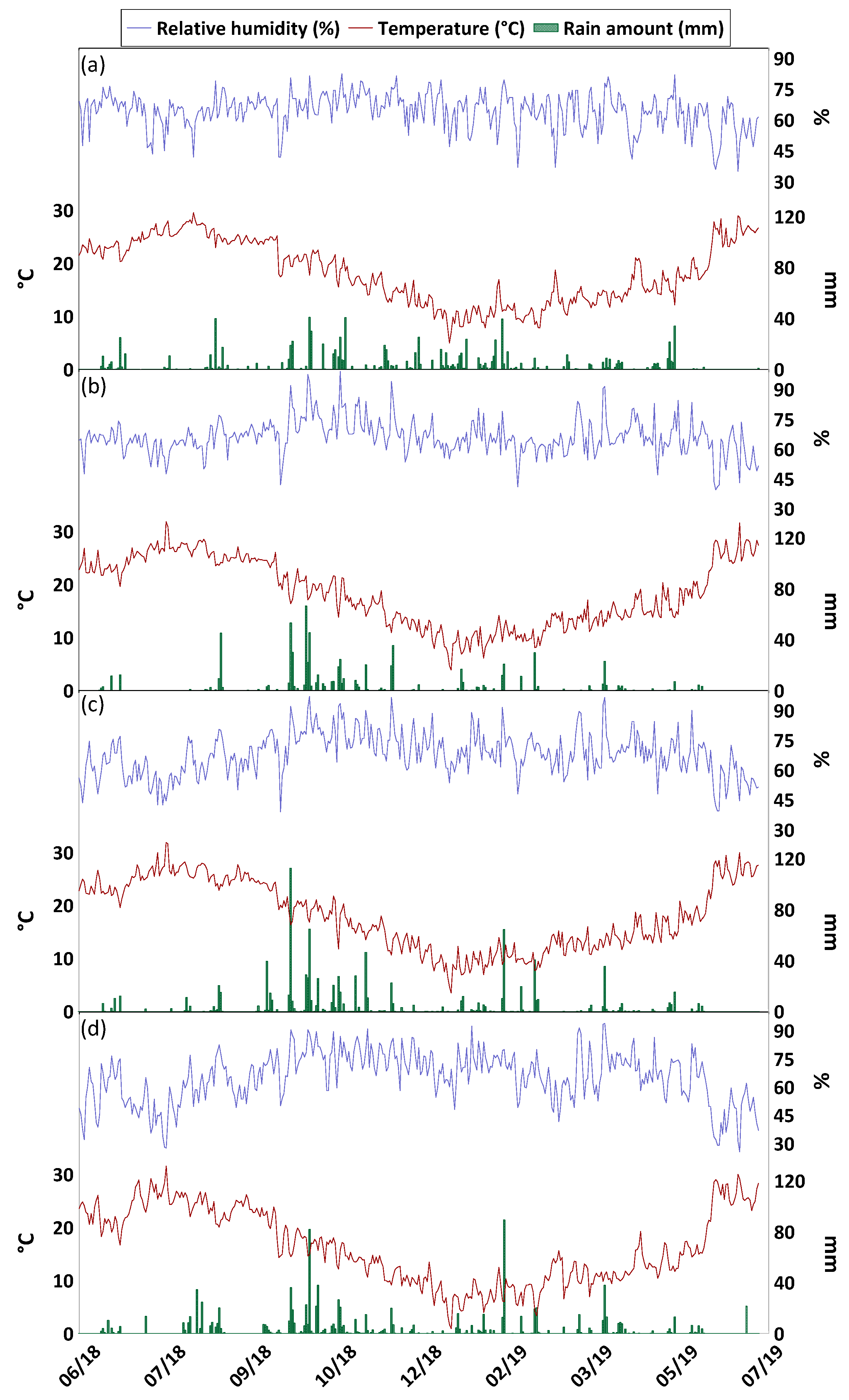

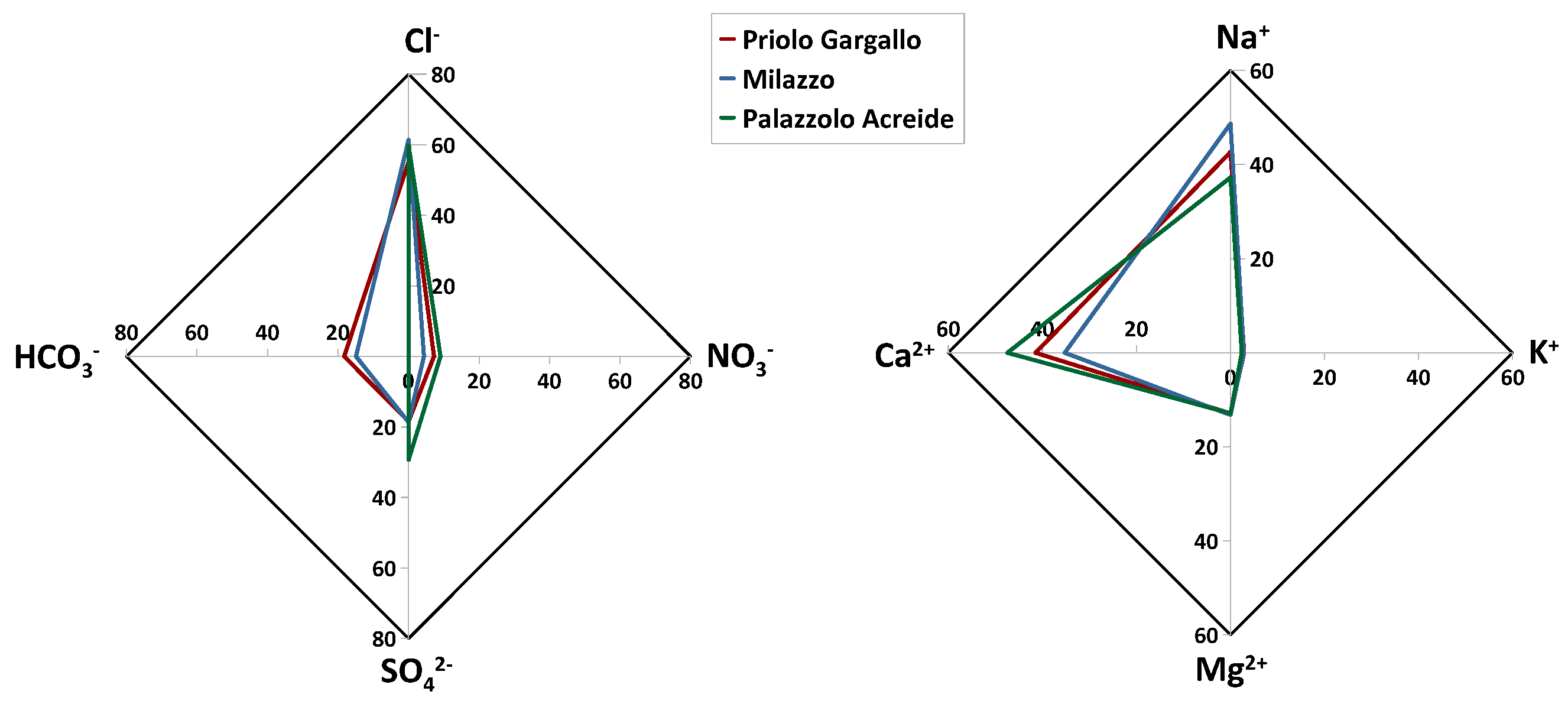
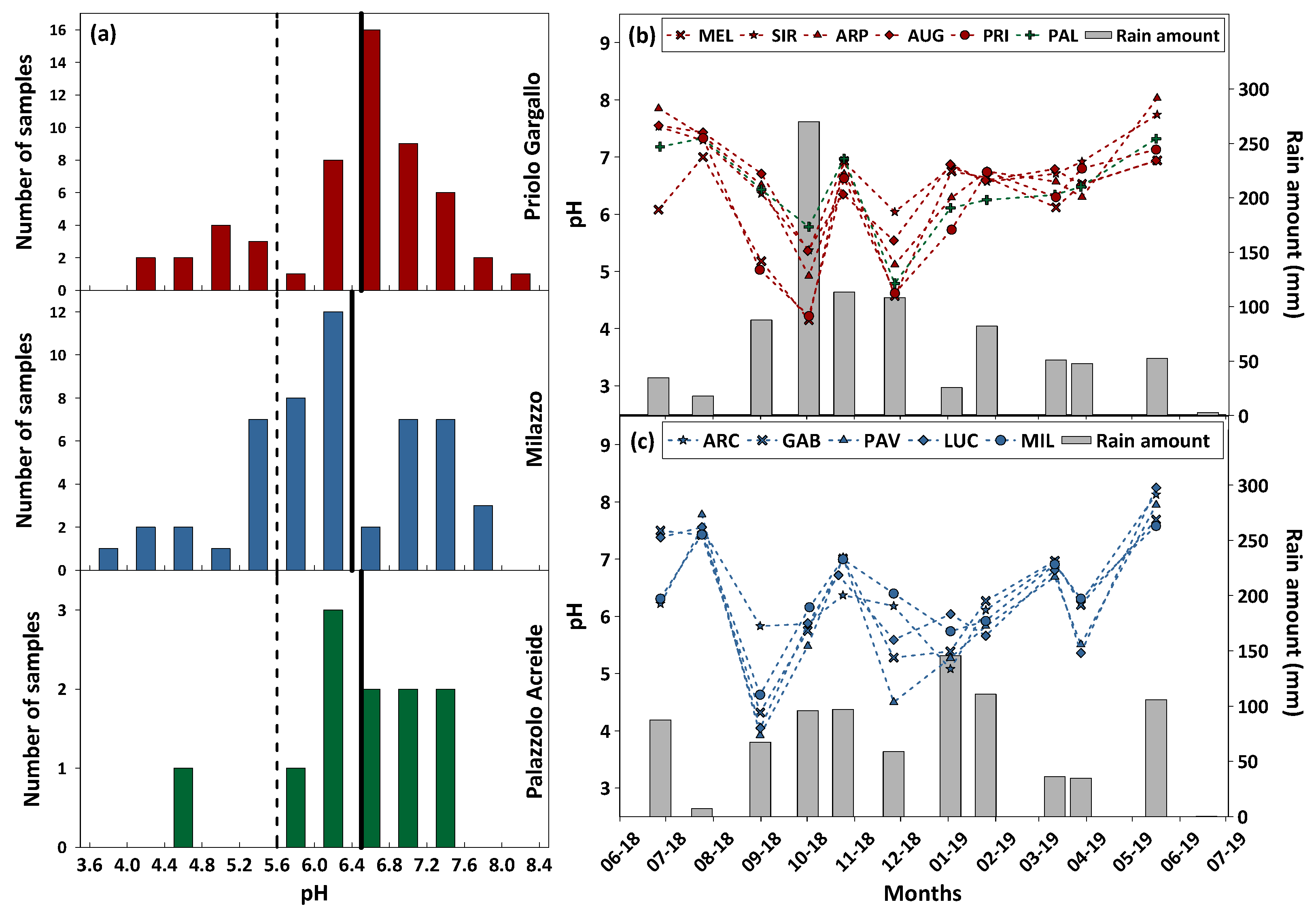
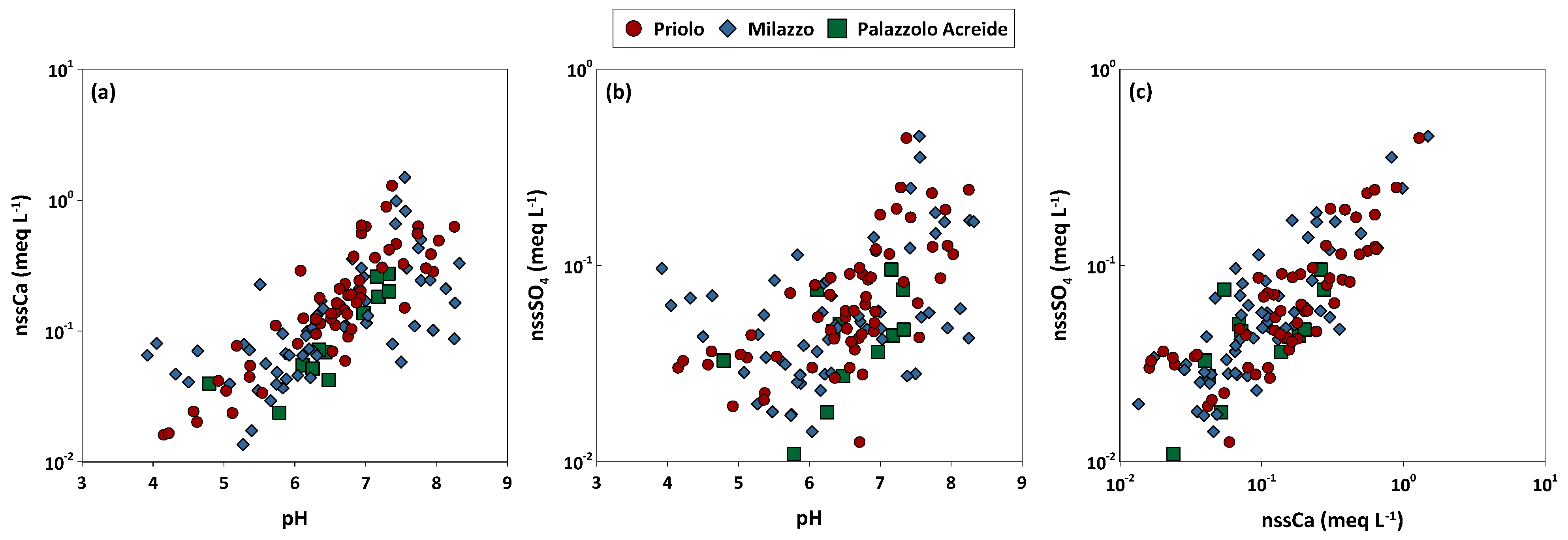
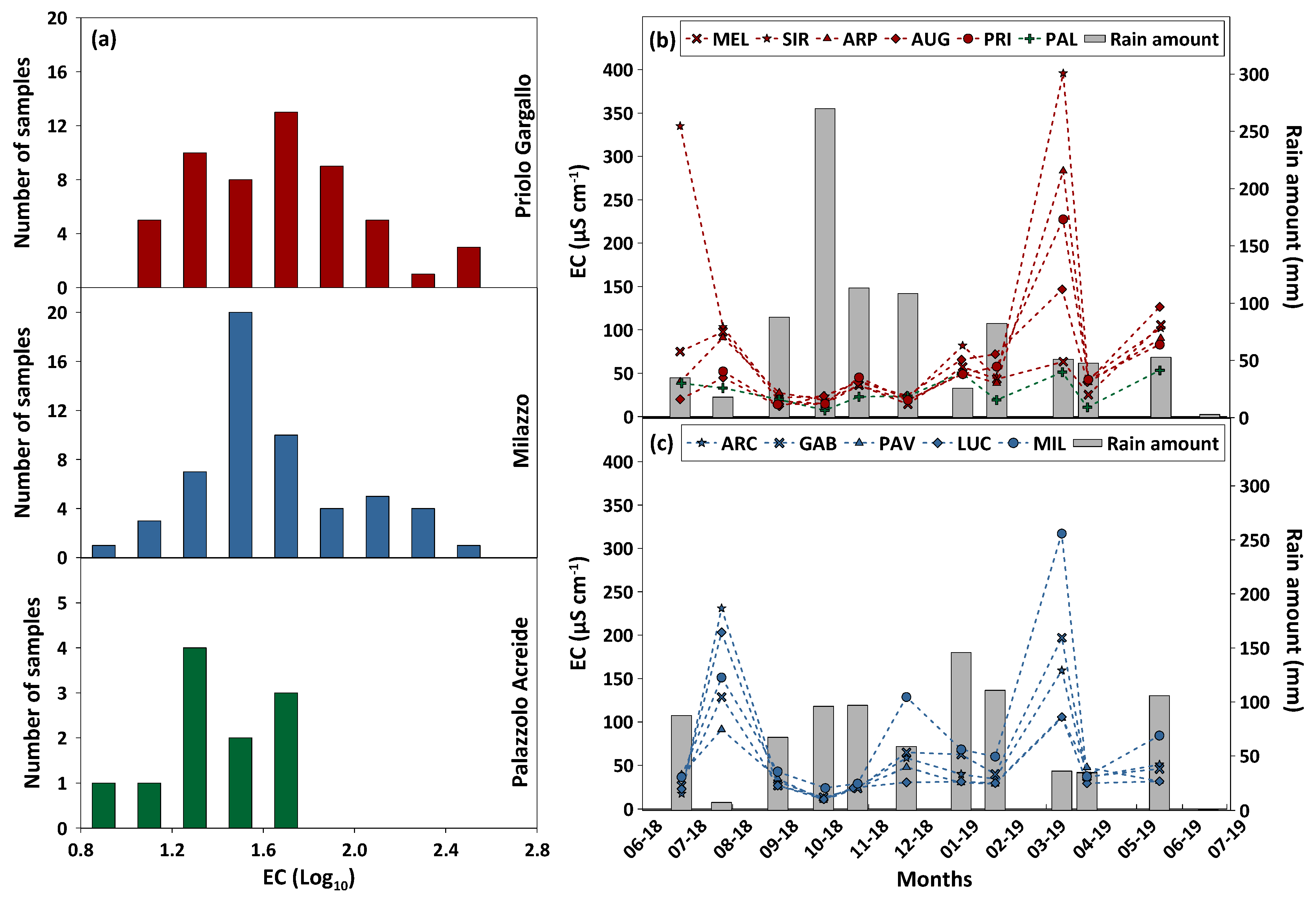

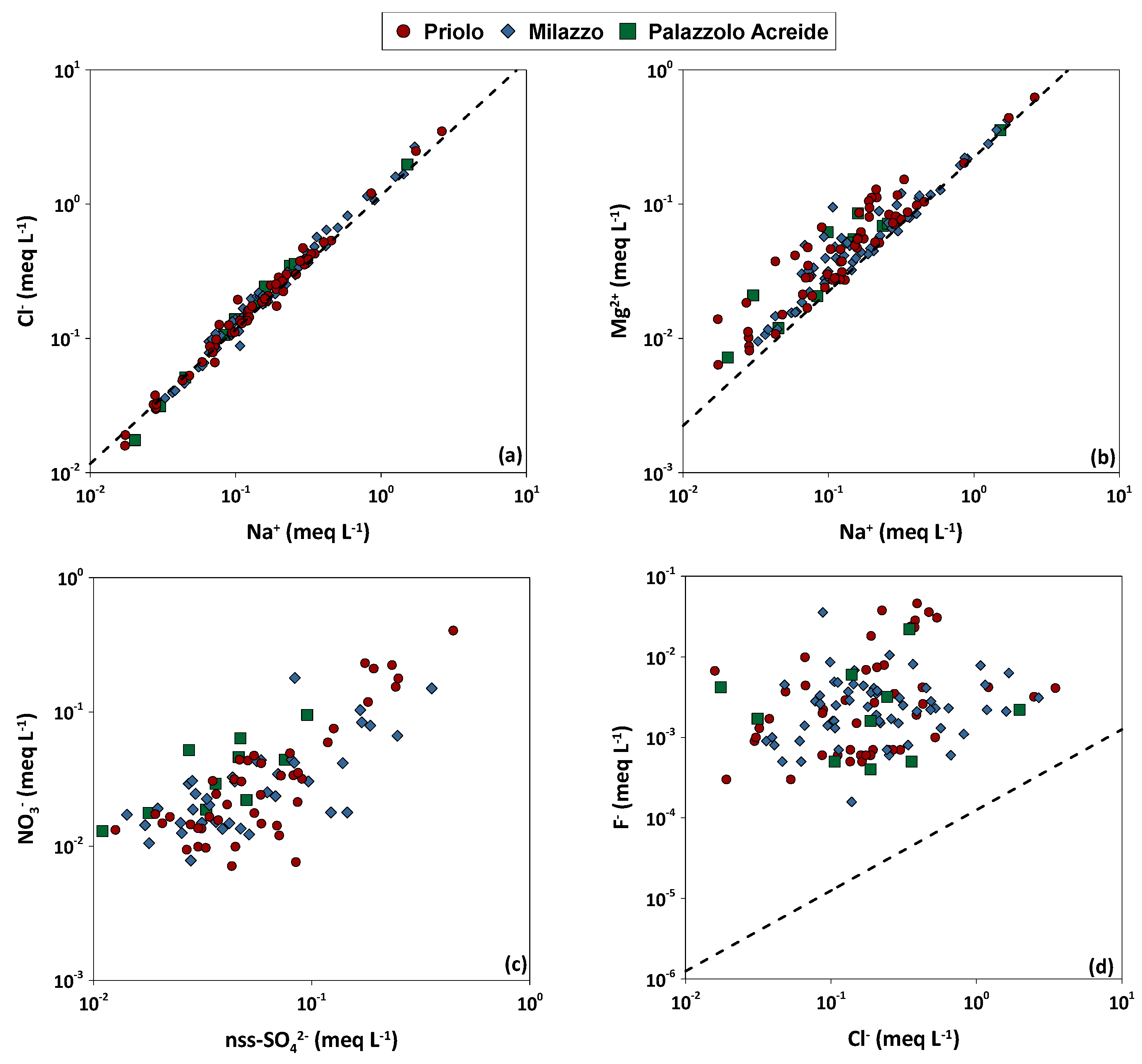
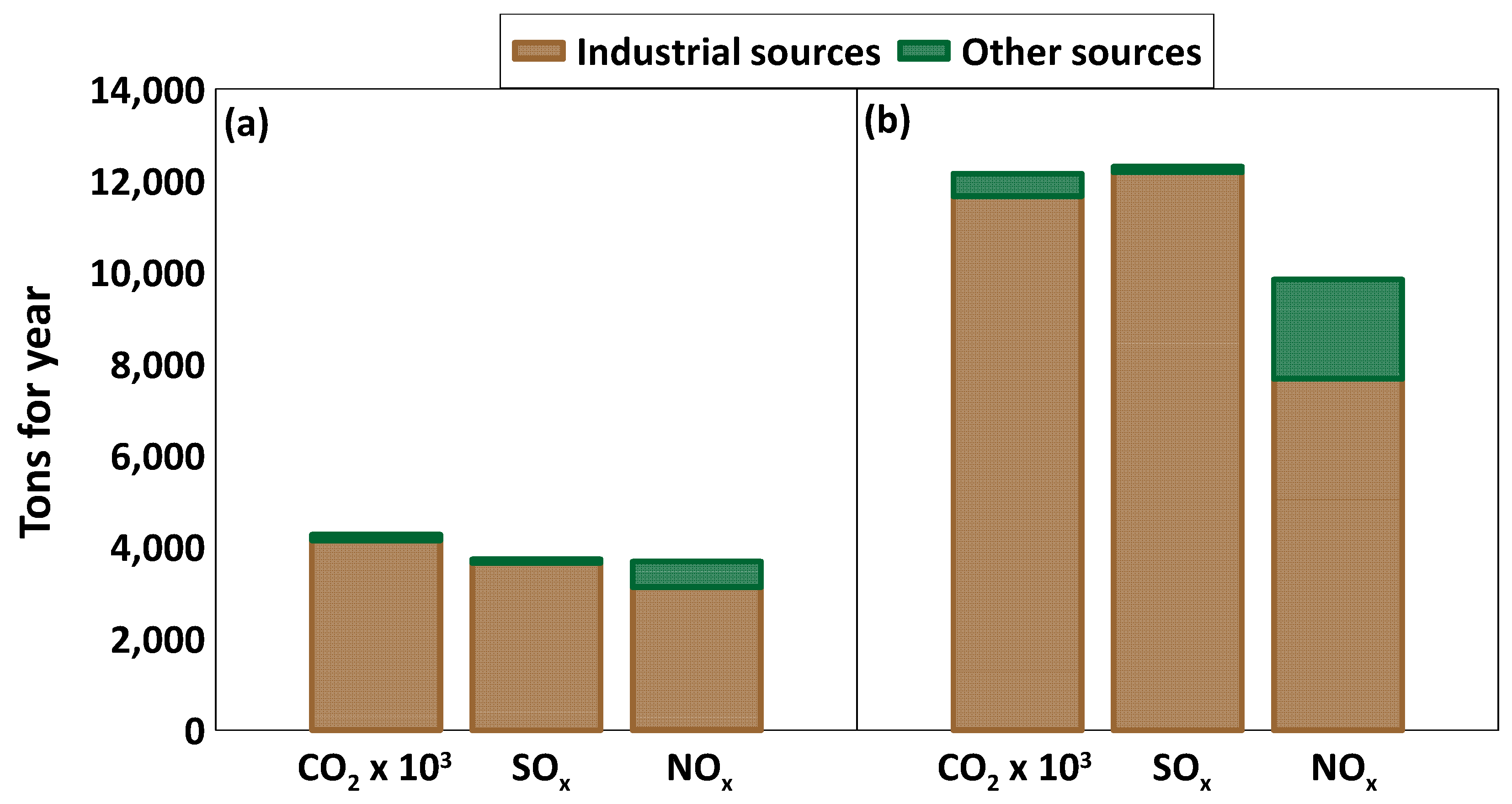
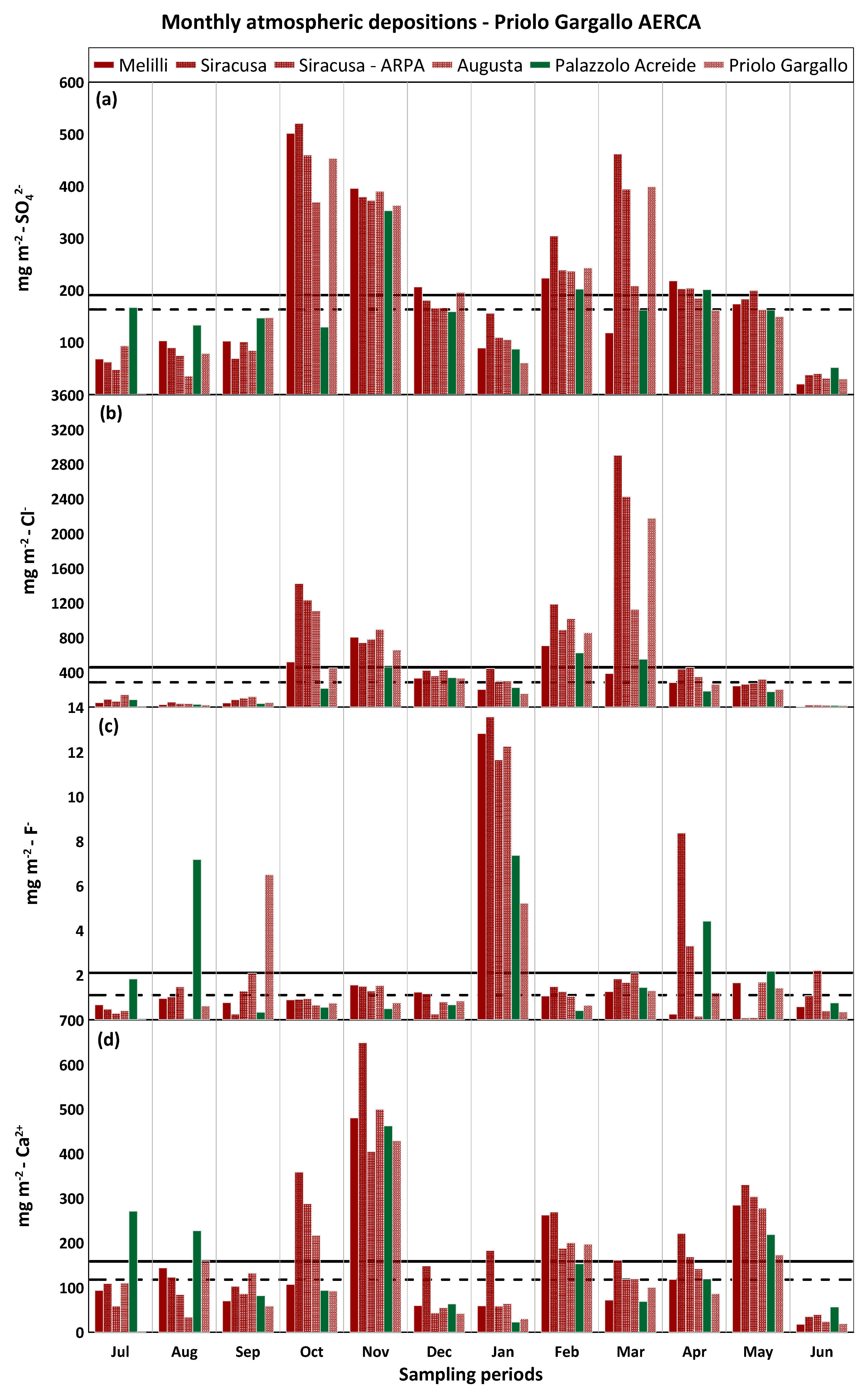
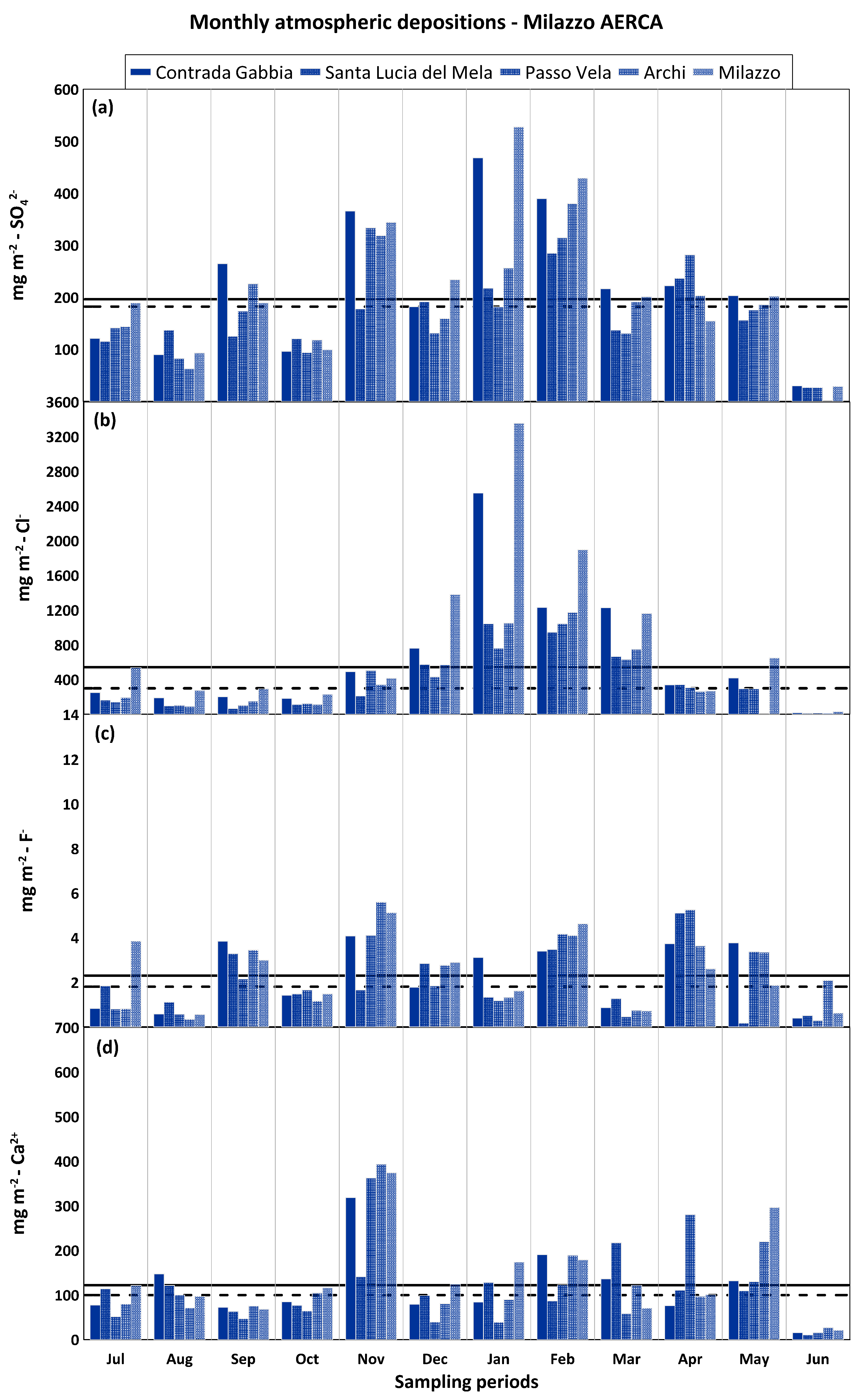
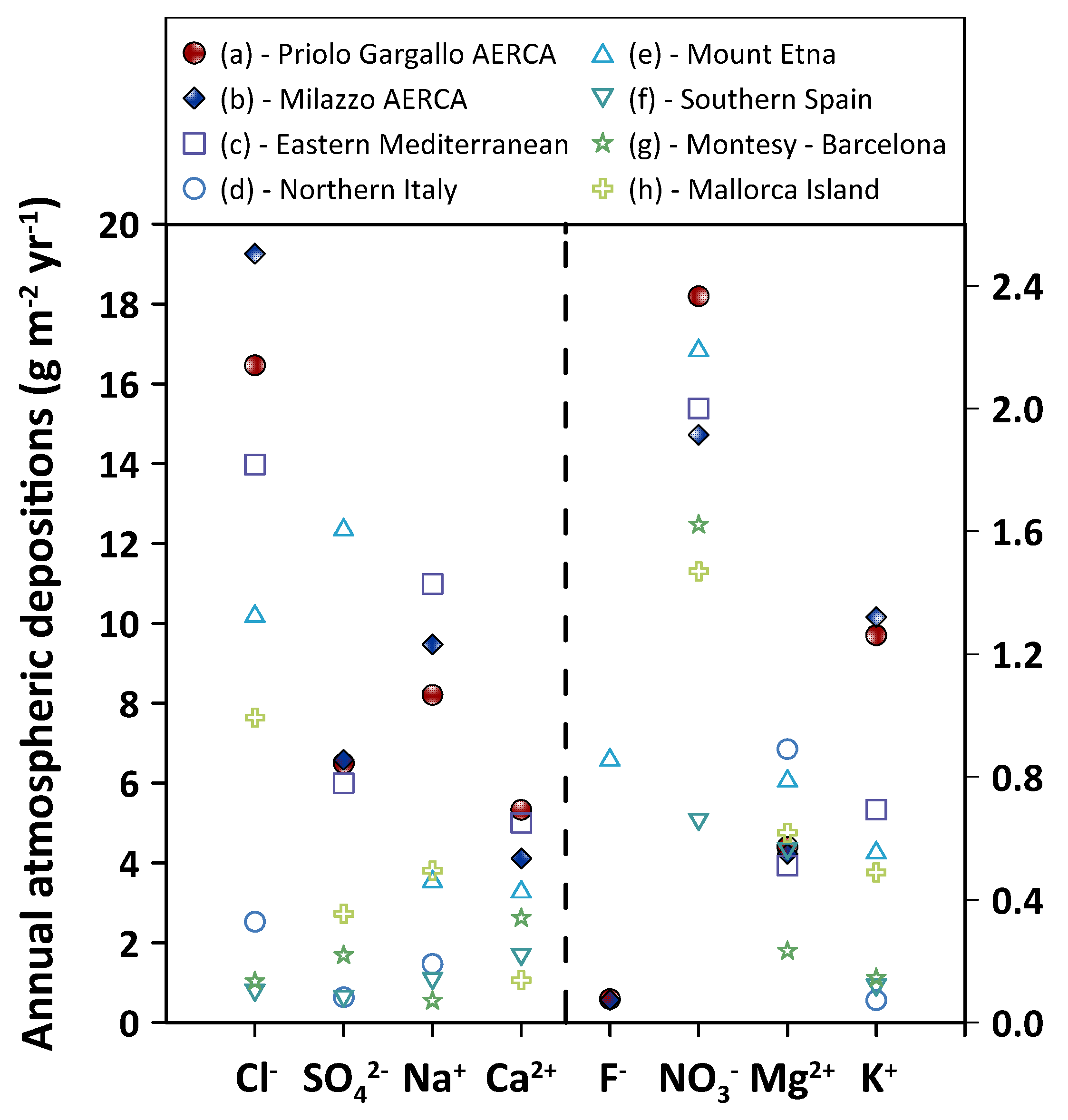
| Locality | ID | AERCA | Type of Site | Position UTM WGS84 | Altitude (m a.s.l.) | Distance from Sea (km) |
|---|---|---|---|---|---|---|
| Contrada Gabbia | GAB | Milazzo | Industrial | 33S 527148 4228670 | 15 | 0.43 |
| Archi | ARC | Milazzo | Industrial | 33S 524760 4227710 | 34 | 1.05 |
| Pace del Mela | PAV | Milazzo | Urban | 33S 527271 4226464 | 107 | 2.55 |
| S. Lucia del Mela | LUC | Milazzo | Urban | 33S 524222 4222617 | 150 | 6.11 |
| Milazzo | MIL | Milazzo | Urban | 33S 520799 4230495 | 20 | 0.36 |
| Siracusa | SIR | Priolo Gargallo | Urban | 33S 523613 4106275 | 63 | 0.44 |
| Siracusa | ARP | Priolo Gargallo | Urban | 33S 524666 4104347 | 76 | 1.95 |
| Melilli | MEL | Priolo Gargallo | Urban | 33S 511433 4115107 | 249 | 5.15 |
| Augusta | AUG | Priolo Gargallo | Industrial | 33S 519388 4120387 | 28 | 0.10 |
| Priolo Gargallo | PRI | Priolo Gargallo | Industrial | 33S 514767 4112657 | 94 | 2.97 |
| Palazzolo Acreide | PAL | - | Semi-Urban | 33S 491728 4102587 | 642 | 28.2 |
| Site | pH | EC | F− | Cl− | NO3− | SO42− | Na+ | K+ | Mg2+ | Ca2+ | |
|---|---|---|---|---|---|---|---|---|---|---|---|
| μS cm−1 | meq L−1 | meq L−1 | meq L−1 | meq L−1 | meq L−1 | meq L−1 | meq L−1 | meq L−1 | |||
| Melilli | Min | 4.15 | 15 | <0.003 | 0.03 | 0.014 | 0.04 | 0.03 | 0.002 | 0.01 | 0.03 |
| Max | 7.95 | 106 | 0.0461 | 0.43 | 0.119 | 0.19 | 0.30 | 0.037 | 0.11 | 0.63 | |
| VWM | 30 | 0.13 | 0.022 | 0.06 | 0.09 | 0.006 | 0.03 | 0.11 | |||
| ss (%) | 88 | 0 | 20 | 100 | 33 | 68 | 4 | ||||
| nss (%) | 12 | 100 | 80 | 0 | 67 | 32 | 96 | ||||
| Siracusa | Min | 5.37 | 21 | <0.003 | 0.05 | <0.005 | 0.03 | 0.05 | 0.003 | 0.02 | 0.08 |
| Max | 7.74 | 396 | 0.0306 | 3.49 | 0.22 | 0.41 | 2.62 | 0.097 | 0.62 | 0.90 | |
| VWM | 58 | 0.32 | 0.014 | 0.07 | 0.25 | 0.009 | 0.07 | 0.17 | |||
| ss (%) | 90 | 0 | 42 | 100 | 60 | 83 | 6 | ||||
| nss (%) | 10 | 100 | 58 | 0 | 40 | 17 | 94 | ||||
| Siracusa-Arpa | Min | 4.92 | 19 | <0.003 | 0.09 | <0.005 | 0.03 | 0.07 | 0.002 | 0.02 | 0.05 |
| Max | 8.25 | 283 | 0.0283 | 2.49 | 0.403 | 0.48 | 1.74 | 0.122 | 0.44 | 1.30 | |
| VWM | 44 | 0.28 | 0.018 | 0.07 | 0.21 | 0.007 | 0.06 | 0.12 | |||
| ss (%) | 86 | 0 | 37 | 100 | 63 | 79 | 8 | ||||
| nss (%) | 14 | 100 | 63 | 0 | 37 | 21 | 92 | ||||
| Augusta | Min | 5.36 | 12 | <0.003 | 0.03 | <0.005 | 0.02 | 0.03 | 0.002 | 0.01 | 0.06 |
| Max | 7.92 | 147 | 0.0359 | 1.21 | 0.231 | 0.22 | 0.86 | 0.038 | 0.20 | 0.66 | |
| VWM | 40 | 0.23 | 0.012 | 0.06 | 0.18 | 0.006 | 0.05 | 0.13 | |||
| ss (%) | 90 | 0 | 37 | 100 | 66 | 80 | 6 | ||||
| nss (%) | 10 | 100 | 63 | 0 | 34 | 20 | 94 | ||||
| Palazzolo Acreide | Min | 4.79 | 7 | <0.003 | 0.02 | <0.005 | 0.01 | 0.02 | 0.002 | 0.01 | 0.03 |
| Max | 7.33 | 53 | 0.0232 | 0.39 | 0.035 | 0.11 | 0.32 | 0.015 | 0.08 | 0.28 | |
| VWM | 25 | 0.09 | 0.016 | 0.04 | 0.08 | 0.005 | 0.03 | 0.10 | |||
| ss (%) | 97 | 0 | 21 | 100 | 37 | 66 | 3 | ||||
| nss (%) | 3 | 100 | 79 | 0 | 63 | 34 | 97 | ||||
| Priolo Gargallo | Min | 4.62 | 14 | <0.003 | 0.02 | <0.005 | 0.04 | 0.02 | 0.020 | 0.01 | 0.02 |
| Max | 7.33 | 227 | 0.0220 | 1.98 | 0.095 | 0.27 | 1.52 | 0.168 | 0.35 | 0.42 | |
| VWM | 41 | 0.23 | 0.022 | 0.07 | 0.18 | 0.007 | 0.05 | 0.09 | |||
| ss (%) | 89 | 0 | 31 | 100 | 54 | 81 | 8 | ||||
| nss (%) | 11 | 100 | 69 | 0 | 46 | 19 | 92 | ||||
| Contrada Gabbia | Min | 4.32 | 27 | <0.003 | 0.06 | <0.005 | 0.02 | 0.06 | 0.002 | 0.02 | 0.03 |
| Max | 7.78 | 197 | 0.0068 | 1.60 | 0.079 | 0.21 | 1.26 | 0.030 | 0.28 | 0.68 | |
| VWM | 47 | 0.31 | 0.014 | 0.07 | 0.23 | 0.007 | 0.06 | 0.09 | |||
| ss (%) | 84 | 0 | 38 | 100 | 75 | 90 | 11 | ||||
| nss (%) | 16 | 100 | 62 | 0 | 25 | 10 | 89 | ||||
| S. Lucia del Mela | Min | 4.05 | 11 | <0.003 | 0.04 | <0.005 | 0.03 | 0.03 | 0.030 | 0.01 | 0.04 |
| Max | 8.26 | 203 | 0.0086 | 0.64 | 0.150 | 0.18 | 0.42 | 0.162 | 0.12 | 0.84 | |
| VWM | 33 | 0.18 | 0.019 | 0.05 | 0.13 | 0.007 | 0.04 | 0.09 | |||
| ss (%) | 86 | 0 | 30 | 100 | 43 | 85 | 6 | ||||
| nss (%) | 14 | 100 | 70 | 0 | 57 | 15 | 94 | ||||
| Passo Vela | Min | 3.92 | 10 | <0.003 | 0.04 | <0.005 | 0.02 | 0.04 | 0.003 | 0.01 | 0.02 |
| Max | 7.95 | 105 | 0.0049 | 0.82 | 0.179 | 0.18 | 0.59 | 0.033 | 0.13 | 0.51 | |
| VWM | 34 | 0.17 | 0.020 | 0.06 | 0.14 | 0.006 | 0.04 | 0.08 | |||
| ss (%) | 91 | 0 | 29 | 100 | 51 | 80 | 8 | ||||
| nss (%) | 9 | 100 | 71 | 0 | 49 | 20 | 92 | ||||
| Archi | Min | 5.08 | 13 | <0.003 | 0.04 | <0.005 | 0.03 | 0.04 | 0.002 | 0.01 | 0.05 |
| Max | 8.13 | 159 | 0.0356 | 1.18 | 0.072 | 0.56 | 0.90 | 0.077 | 0.22 | 1.53 | |
| VWM | 38 | 0.20 | 0.008 | 0.07 | 0.18 | 0.007 | 0.05 | 0.12 | |||
| ss (%) | 100 | 0 | 30 | 100 | 54 | 83 | 7 | ||||
| nss (%) | 0 | 100 | 70 | 0 | 46 | 17 | 93 | ||||
| Milazzo | Min | 4.63 | 24 | <0.003 | 0.11 | <0.005 | 0.03 | 0.07 | 0.003 | 0.03 | 0.06 |
| Max | 8.32 | 317 | 0.0105 | 2.68 | 0.103 | 0.42 | 1.70 | 0.103 | 0.42 | 1.05 | |
| VWM | 64 | 0.47 | 0.014 | 0.08 | 0.35 | 0.009 | 0.09 | 0.13 | |||
| ss (%) | 86 | 0 | 50 | 100 | 90 | 88 | 12 | ||||
| nss (%) | 14 | 100 | 50 | 0 | 10 | 12 | 88 |
| (a) | F− | Cl− | NO3− | SO42− | Na+ | K+ | Mg2+ | Ca2+ | nss-SO42− |
|---|---|---|---|---|---|---|---|---|---|
| F− | <0.10 | 0.19 | 0.45 | <0.10 | 0.09 | <0.10 | 0.13 | 0.60 | |
| Cl− | <0.10 | <0.10 | 0.43 | 0.98 | 0.22 | 0.95 | 0.20 | 0.11 | |
| NO3− | 0.19 | <0.10 | 0.30 | <0.10 | 0.37 | <0.10 | 0.22 | 0.47 | |
| SO42− | 0.45 | 0.43 | 0.30 | 0.49 | 0.74 | 0.57 | 0.81 | 0.86 | |
| Na+ | <0.10 | 0.98 | <0.10 | 0.49 | 0.27 | 0.97 | 0.27 | 0.15 | |
| K+ | 0.09 | 0.22 | 0.37 | 0.74 | 0.27 | 0.36 | 0.60 | 0.71 | |
| Mg2+ | <0.10 | 0.95 | <0.10 | 0.57 | 0.97 | 0.36 | 0.35 | 0.21 | |
| Ca2+ | 0.13 | 0.20 | 0.22 | 0.81 | 0.27 | 0.60 | 0.35 | 0.78 | |
| nss-SO42− | 0.60 | 0.11 | 0.47 | 0.86 | 0.15 | 0.71 | 0.21 | 0.78 | |
| (b) | F− | Cl− | NO3− | SO42− | Na+ | K+ | Mg2+ | Ca2+ | nss-SO42− |
| F− | <0.10 | 0.11 | 0.15 | <0.10 | 0.09 | <0.10 | 0.09 | 0.19 | |
| Cl− | <0.10 | <0.10 | 0.37 | 0.99 | 0.15 | 0.95 | <0.10 | <0.10 | |
| NO3− | 0.11 | <0.10 | 0.79 | <0.10 | 0.21 | 0.11 | 0.75 | 0.89 | |
| SO42− | 0.15 | 0.37 | 0.79 | 0.39 | 0.44 | 0.52 | 0.59 | 0.71 | |
| Na+ | <0.10 | 0.99 | <0.10 | 0.39 | 0.16 | 0.96 | <0.10 | <0.10 | |
| K+ | 0.09 | 0.15 | 0.21 | 0.44 | 0.16 | 0.23 | 0.17 | 0.33 | |
| Mg2+ | <0.10 | 0.95 | 0.11 | 0.52 | 0.96 | 0.23 | 0.07 | 0.06 | |
| Ca2+ | 0.09 | <0.10 | 0.75 | 0.59 | <0.10 | 0.17 | 0.07 | 0.82 | |
| nss-SO42− | 0.19 | <0.10 | 0.89 | 0.71 | <0.10 | 0.33 | 0.06 | 0.82 |
| Atmospheric Depositions (g m−2 yr−1) | F− | Cl− | NO3− | SO42− | Na+ | K+ | Mg2+ | Ca2+ | Rainfall mm | |
|---|---|---|---|---|---|---|---|---|---|---|
| Priolo Gargallo AERCA | Melilli | 0.08 ± 0.011 | 9.84 ± 0.65 | 3.06 ± 0.18 | 6.11 ± 0.37 | 4.81 ± 0.31 | 0.55 ± 0.03 | 0.85 ± 0.05 | 4.92 ± 0.37 | 805 |
| Siracusa | 0.09 ± 0.014 | 25.35 ± 3.30 | 1.94 ± 0.24 | 7.77 ± 0.55 | 12.74 ± 1.61 | 0.78 ± 0.10 | 1.84 ± 0.20 | 7.58 ± 0.44 | 816 | |
| Siracusa-Arpa | 0.08 ± 0.011 | 21.68 ± 2.75 | 2.38 ± 0.27 | 7.08 ± 0.47 | 10.44 ± 1.26 | 0.61 ± 0.05 | 1.57 ± 0.17 | 5.29 ± 0.38 | 801 | |
| Augusta | 0.08 ± 0.011 | 16.91 ± 1.36 | 1.50 ± 0.17 | 5.79 ± 0.31 | 8.48 ± 0.66 | 0.47 ± 0.02 | 1.27 ± 0.09 | 5.32 ± 0.37 | 744 | |
| Priolo Gargallo | 0.06 ± 0.008 | 16.51 ± 2.53 | 2.72 ± 0.17 | 6.74 ± 0.48 | 8.22 ± 1.26 | 0.56 ± 0.05 | 1.22 ± 0.15 | 3.80 ± 0.27 | 733 | |
| Median | 0.08 ± 0.011 | 16.91 ± 2.53 | 2.38 ± 0.18 | 6.74 ± 0.47 | 8.48 ± 1.26 | 0.56 ± 0.05 | 1.27 ± 0.15 | 5.29 ± 0.37 | 801 | |
| Milazzo AERCA | Contrada Gabbia | 0.08 ± 0.005 | 24.30 ± 2.49 | 1.88 ± 0.17 | 7.68 ± 0.42 | 11.40 ± 1.07 | 0.57 ± 0.04 | 1.52 ± 0.12 | 3.97 ± 0.19 | 798 |
| Santa Lucia del Mela | 0.06 ± 0.003 | 13.42 ± 1.14 | 2.45 ± 0.13 | 5.36 ± 0.19 | 6.42 ± 0.55 | 0.55 ± 0.03 | 0.91 ± 0.07 | 3.80 ± 0.22 | 763 | |
| Passo Vela | 0.07 ± 0.005 | 12.84 ± 0.93 | 2.60 ± 0.29 | 5.65 ± 0.22 | 6.54 ± 0.47 | 0.47 ± 0.02 | 0.98 ± 0.06 | 3.30 ± 0.21 | 755 | |
| Archi | 0.08 ± 0.005 | 13.49 ± 1.25 | 0.92 ± 0.12 | 6.40 ± 0.30 | 7.59 ± 0.60 | 0.52 ± 0.03 | 1.10 ± 0.08 | 4.43 ± 0.27 | 680 | |
| Milazzo | 0.08 ± 0.003 | 32.25 ± 3.18 | 1.72 ± 0.16 | 7.81 ± 0.45 | 15.42 ± 1.52 | 0.64 ± 0.04 | 2.10 ± 0.19 | 5.05 ± 0.34 | 699 | |
| Median | 0.08 ± 0.005 | 13.49 ± 1.25 | 1.88 ± 0.16 | 6.40 ± 0.30 | 7.59 ± 0.60 | 0.55 ± 0.03 | 1.10 ± 0.09 | 3.97 ± 0.22 | 755 | |
| Palazzolo Acreide | 0.08 ± 0.008 | 8.49 ± 0.64 | 2.58 ± 0.14 | 5.47 ± 0.18 | 4.57 ± 0.34 | 0.45 ± 0.01 | 0.82 ± 0.05 | 5.06 ± 0.32 | 937 |
Disclaimer/Publisher’s Note: The statements, opinions and data contained in all publications are solely those of the individual author(s) and contributor(s) and not of MDPI and/or the editor(s). MDPI and/or the editor(s) disclaim responsibility for any injury to people or property resulting from any ideas, methods, instructions or products referred to in the content. |
© 2023 by the authors. Licensee MDPI, Basel, Switzerland. This article is an open access article distributed under the terms and conditions of the Creative Commons Attribution (CC BY) license (https://creativecommons.org/licenses/by/4.0/).
Share and Cite
Brugnone, F.; D’Alessandro, W.; Parello, F.; Liotta, M.; Bellomo, S.; Prano, V.; Li Vigni, L.; Sprovieri, M.; Calabrese, S. Atmospheric Deposition around the Industrial Areas of Milazzo and Priolo Gargallo (Sicily–Italy)—Part A: Major Ions. Int. J. Environ. Res. Public Health 2023, 20, 3898. https://doi.org/10.3390/ijerph20053898
Brugnone F, D’Alessandro W, Parello F, Liotta M, Bellomo S, Prano V, Li Vigni L, Sprovieri M, Calabrese S. Atmospheric Deposition around the Industrial Areas of Milazzo and Priolo Gargallo (Sicily–Italy)—Part A: Major Ions. International Journal of Environmental Research and Public Health. 2023; 20(5):3898. https://doi.org/10.3390/ijerph20053898
Chicago/Turabian StyleBrugnone, Filippo, Walter D’Alessandro, Francesco Parello, Marcello Liotta, Sergio Bellomo, Vincenzo Prano, Lorenza Li Vigni, Mario Sprovieri, and Sergio Calabrese. 2023. "Atmospheric Deposition around the Industrial Areas of Milazzo and Priolo Gargallo (Sicily–Italy)—Part A: Major Ions" International Journal of Environmental Research and Public Health 20, no. 5: 3898. https://doi.org/10.3390/ijerph20053898
APA StyleBrugnone, F., D’Alessandro, W., Parello, F., Liotta, M., Bellomo, S., Prano, V., Li Vigni, L., Sprovieri, M., & Calabrese, S. (2023). Atmospheric Deposition around the Industrial Areas of Milazzo and Priolo Gargallo (Sicily–Italy)—Part A: Major Ions. International Journal of Environmental Research and Public Health, 20(5), 3898. https://doi.org/10.3390/ijerph20053898









